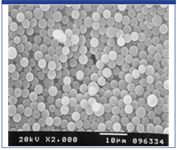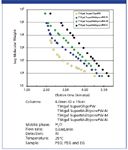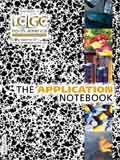Reduce Oligosaccharide Analysis Time with TSKgel SuperOligoPW Size Exclusion Chromatography Columns Packed with Three Micron Particles
At the 2011 Pittsburgh Conference, Tosoh Corporation introduced a new line of high efficiency columns for the analysis of water-soluble polymers by gel filtration chromatography.
At the 2011 Pittsburgh Conference, Tosoh Corporation introduced a new line of high efficiency columns for the analysis of water-soluble polymers by gel filtration chromatography. The new product line consists of four columns, of which three contain particles that have been designed with the multi-pore particle synthesis technology which Tosoh scientists pioneered in the mid 1990s. The fourth column, TSKgel SuperOligoPW, the topic of this application note, was developed to reduce the analysis time for oligosaccharides and other oligomers with molecular masses in the range of 100 and 3000. Currently, the TSKgel G-Oligo-PW column, which contains spherical 7µm particles packed in a 7.8 mm ID × 30 cm column, is the preferred column for size analysis of neutral oligosaccharides by gel filtration chromatography. This application note will demonstrate that analysis times of oligosaccharide separations can be reduced by 50%, which in turn can result in lowering cost, improving turnaround time, offering better service, or any combination of these factors.
The characteristics of the TSKgel SuperOligoPW column,together with those of the TSKgel SuperMultiporePW columns, are shown in Table I.

Table I: TSKgel SuperOligoPW and SuperMultiporePW gel filtration columns
As shown in Table I, the TSKgel SuperOligoPW column is packed with monodisperse particles. The scanning electron micrograph (SEM) in Figure 1 illustrates the narrow distribution of particle sizes, which helps to reduce the pressure drop across the column.

Figure 1: Scanning electron micrograph (SEM) of particles contained in TSKgel SuperOligoPW columns.
While a moderate column back pressure helps to reduce wear and tear on the HPLC system, lowering column back pressure is particularly important when working with multiple columns coupled in series, such as shown in the accompanying applications.

Figure 2: Analysis of a maltodextrin sample on TSKgel SuperOligoPW and G-Oligo-PW columns.
As is the case in all modes of HPLC, reducing the particle size by a factor of two (in this case from 7 to 3 µm) either results in (1) the same analysis time but with much better resolution when using columns of the same length, or in (2) the same resolution but at least a 50% reduction in analysis time if the length of the smaller particle size column is half that of the larger particle size column. This last benefit is illustrated in Figure 2, which shows that for a maltodextrin sample, with glucose units varying in length from maltoheptose to glucose, approximately the same resolution can be achieved in less than half the time on the 15 cm TSKgel SuperOligoPW column when compared to the conventional 30 cm TSKgel G-Oligo-PW column.

Figure 3: Calibration curves for TSKgel SuperOligoPW and SuperMultiporePW columns.
Figure 3 shows the calibration curves for each of the new TSKgel PW-type columns for polyethylene oxide (PEO), polyethylene glycol (PEG), and ethylene glycol (EG) standards. In contrast to the three TSKgel SuperMultiporePW columns, the calibration curve for the TSKgel SuperOligoPW column has a limited linear range that makes the column most suitable for oligosaccharides and other water-soluble polymers from a degree of polymerization of 1 to a molar mass of about 3000.

Figure 4: Analysis of maltopentose hydrolysate on TSKgel SuperOligoPW and G-Oligo-PW columns.
A comparative analysis of maltopentose hydrolysate is shown in Figure 4. Of each column type, four columns are coupled in series. It is clear that the shorter TSKgel SuperOligoPW columns allow for a substantial reduction in analysis time while resolution on this column set is very similar to that on four TSKgel G-Oligo-PW columns. Like the results shown in Figure 2, a 10 µL injection on the four 15 cm columns results in similar peak heights as obtained from a 50 µL injection on the set of four 30 cm columns. Part of this is due to smaller particle size, which leads to higher efficiency and thus less band broadening, but the shorter column length and the use of a narrower column diameter also play a role. The relative contributions of each of these band broadening effects have been calculated in Table II.

Table II: Relative importance of individual contributions to band broadening
Notes
To calculate the relative importance of various contributions to peak height, Table II shows two additional column dimensions as intermediate cases. The peak height of the 6 mm ID × 15 cm TSKgel SuperOligoPW column was arbitrarily selected as 100%. If we assume that a 7.8 mm ID × 15 cm column packed with the same 3 µm particles would again have 16,000 theoretical plates, the signal would be 41% lower simply due to the larger internal diameter of the column. If the number of plates is reduced to 14,000 the peak height drops another 4%, while a 30 cm column of 7.8 mm ID and 14,000 plates, representing the conventional TSKgel G-Oligo-PW column, results in a further reduction of the peak height, down to 28% of the peak height of the new column. In other words, a 40 µL injection, rather than a 50 µL injection, would have resulted in the same peak heights at the same signal to noise ratio on both columns.
Conclusion
A new column for the analysis of oligosaccharides by size exclusion chromatography, TSKgel SuperOligoPW, provides the same resolution in half the analysis time and with a 4- to 5-fold improvement in sensitivity compared to the conventional TSKgel G-Oligo-PW column. This advancement was made possible by packing 3 µm monodisperse spherical particles in 15 cm columns of 6 mm internal diameter. Applications demonstrated the expected benefit of the new column.
Tosoh Bioscience LLC
3604 Horizon Drive, Suite 100, King of Prussia, PA 19406
tel. (484) 805-1219, fax (610) 272-3028
Website: www.tosohbioscience.com

SEC-MALS of Antibody Therapeutics—A Robust Method for In-Depth Sample Characterization
June 1st 2022Monoclonal antibodies (mAbs) are effective therapeutics for cancers, auto-immune diseases, viral infections, and other diseases. Recent developments in antibody therapeutics aim to add more specific binding regions (bi- and multi-specificity) to increase their effectiveness and/or to downsize the molecule to the specific binding regions (for example, scFv or Fab fragment) to achieve better penetration of the tissue. As the molecule gets more complex, the possible high and low molecular weight (H/LMW) impurities become more complex, too. In order to accurately analyze the various species, more advanced detection than ultraviolet (UV) is required to characterize a mAb sample.

.png&w=3840&q=75)

.png&w=3840&q=75)



.png&w=3840&q=75)



.png&w=3840&q=75)














